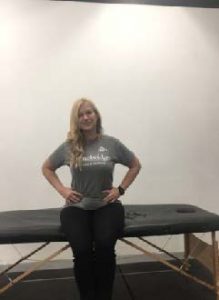When you are told to “brace yourself,” it usually means that you need to be prepared for
something unknown to happen. For this reason, I like the term abdominal bracing. If
we learn how to wake up our abdominal muscles and brace ourselves, our body will be
prepared for whatever challenge the day has to offer. Whether you are playing a sport,
working around the house, or exercising at a fitness class, the abdominal brace is the
key to back protection.
If you’ve followed fitness for as long as I have you may have noticed that the rules
around the use of our core muscles seem to continue to change. In the 80’s and early
90’s there was a lot of talk of abdominal hollowing. This basically means drawing or
sucking the belly in. And if you’ve attended a Pilates class, you may have heard the cue
“draw your belly button to your spine”. I am a Pilates instructor, and a lot of my early
training was based on this type of cueing. Since then however, I have had the
opportunity to train with many respected rehabilitation specialists and when I perform
an exercise, it needs to make sense to me. When I suck my stomach in, I find it difficult
to breathe. In Pilates there are a lot of breathing cues. Inhale to prepare, exhale to
execute the difficult phase of the exercise. This is ok if we are in a very structured
situation, but real life isn’t structured, and it isn’t predictable. If I am playing pickleball
I don’t have time to inhale to prepare for the backhand and then exhale and execute the
movement. Therefore, this type of cueing does not make sense to me for everyday use.
Another strategy that I commonly see people use to stabilize is to push out the
abdominals which is often accompanied by holding their breath. In the gym, I
commonly see weightlifting belts used. The idea is that pushing your abdominals into
the belt will create stabilization. The rationale is that if you step on a full can of soda,
you won’t be able to crush it, but when we empty the can it is easy to crush. The
pressure of pushing the abdominals against belt is creating stabilization. In my mind
this is flawed thinking. Again, you can’t press out and breathe. It teaches our body
“fake” stabilization and requires an external support system.
Instead, I want to talk to you about abdominal bracing for stabilization. Think about
what you would do if you were to prepare yourself for someone to punch you right in
the gut. You would instinctively tense and stiffen your core to brace for the impact.
Instinctively your body knows this is the best way to protect itself. This is exactly what
abdominal bracing is about. Bracing is a term I first picked up while training with Dr.
Stuart McGill who is a leading expert in spine mechanics. When I am personal training
one of the techniques I use to teach bracing is to have a client tie a string around their
waist at the navel. When I ask the client to brace the goal is not to push against the
string which would tighten tension on the string, nor are they to draw in with the navel
which would loosen the string. When we brace our abdominals, there should be no
change in the tension on the string. We are just waking the muscles up to remind them
to protect our back. Whether we are sitting, standing, bending over, or lying down,
remembering to brace the abdominals will help take the load off your spine. This is a
very important concept if you have back pain. We have many layers of abdominal
muscles including the rectus abdominis which are the six-pack ab muscles, the internal
and external obliques which are the muscles running down the side of your torso that
help you to rotate, and the transverse abdominus which is the innermost layer of
muscles which wrap around your spine like a corset.
With abdominal bracing you are simultaneously activating all layers of your core
muscles. This means the entire abdominal wall is activated from all angles, sides, and
directions, causing the three layers of the muscles to bind together. Think of them like
a piece of plywood. Each layer alone is weak but when we glue them together, they are
extremely strong. That is the concept we are working towards. All the layers pressed
together to create a high level of strength and stability. The exercises below are
performed seated and are easy to sneak into your day while watching tv or working at
the computer.
1. The Abdominal Brace
Place your fingers about an inch on the inside of the
hip bones. This is a spot where you can feel the deep layer of muscle called the
transverse. Imagine someone is going to poke or push you. See if you can feel
the muscles tighten. We tend to hold our breath when we brace so count out loud
to 10 to ensure you are breathing while you brace.

2. Brace and Press
Start this exercise with good posture sitting straight and tall
in the chair. Draw the shoulders back so the sternum is in front of the shoulders.
Brace your abdominals and keeping the spine tall press into your knees. Count
out loud to 10.

3. Brace, Press and Lift
Next we are going to stay in that straight posture as we
place both hands on one knee. Start by bracing the abdominals, next press into
the knee. If it’s not bothersome for your back, lift the foot as you press into the
knee. Count out loud for 5-10 seconds.

4. Oblique Brace, Press, Lift, and Hold
Keeping a straight, tall neutral spine
reach one hand across your body. Brace your abdominals as you press into the
knee. Only if it’s comfortable for your back add a leg lift. Count out loud for 5-
10 counts.







